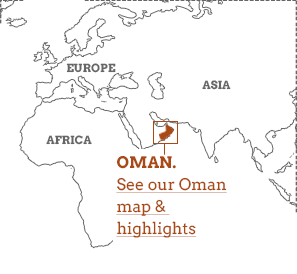Omanís history as a tourist destination is very new. The current Sultan Qaboos bin Said has pulled his country out of the poverty that it endured until the 1970s, driven mainly by lack of food and tribal warfare, by putting it on the map as a destination for classy, high end tourism. Although it may be one of the newest to tourism, Oman is actually the oldest independent Arab country. It still has a proud independent feel, probably driven by the fact that it was very isolated for almost a century.
Read more The impressive forts that you see scattered around Oman, most of which have been beautifully restored, show not only its vulnerability as a country on the edge of the Arabian Peninsula, but also the importance of its maritime history. Before the Portuguese colonised it in 1507, Oman had been led by different internal powers: the Imams, who were powerful Muslim tribe leaders from the interior of the country, and Sultans, who were (still are) products of powerful dynasties that gained strength and wealth through naval and maritime dominance.
The Imams ruled the interior country until 1406, when the first Nabhani Dynasty took over, staying in power until 1624, during which time they also saw the arrival of the Portuguese. Rather than being deterred by Portuguese colonisation of their land, and many others, the Omani Sultanate gathered strength and, after expelling their colonists in 1650, used its naval strength to colonise a fair bit of Arabia themselves, including the United Arab Emirates and southern Baluchistan, as well as Zanzibar and the adjacent coasts of Kenya, Tanzania and Mozambique. This period, led by the new Yarubid dynasty, also led to Oman becoming involved in slave trading.
Omanís international power continued until the early 19th century, when the fifth Sultan of the Al Said dynasty, Said bin Sultan, was pushed out of Asia by European colonists and also pressurised to abandon the slave trade. From this point, Oman pretty much closed its doors to the world, entering a period of internal disputes between Sultans and Imams, fuelled (pun intended) by the discovery of oil in the 1920s. This oil was exploited by the Anglo-Persian Oil Company, leading to a strong relationship between the British and the Sultanate, in order to protect oil reserves from the rebelling Imamate region, the capital of which was Nizwa.
The most significant of these rebellions was in the Dhofar region in the south, which finally ended in 1970, when the British supported a move for the current Sultan Qaboos bin Said, to overthrow his father in a bloodless coup. Since then, Oman has been a relatively peaceful, unified country, with the Sultan pushing for an immediate catch up period of modernisation, in terms of improved food supplies, health, education and infrastructure. There has, however, been unrest over unemployment since the 2010 Arab Spring, which has provoked sporadic protests. There has also been a lot of controversy over the arrest of writers and journalists who are seen to be criticising the Governate.
Amnesty International and other human rights organisations highlight the restriction of freedom of speech, and other human rights violations such as the treatment of domestic staff in Oman.


